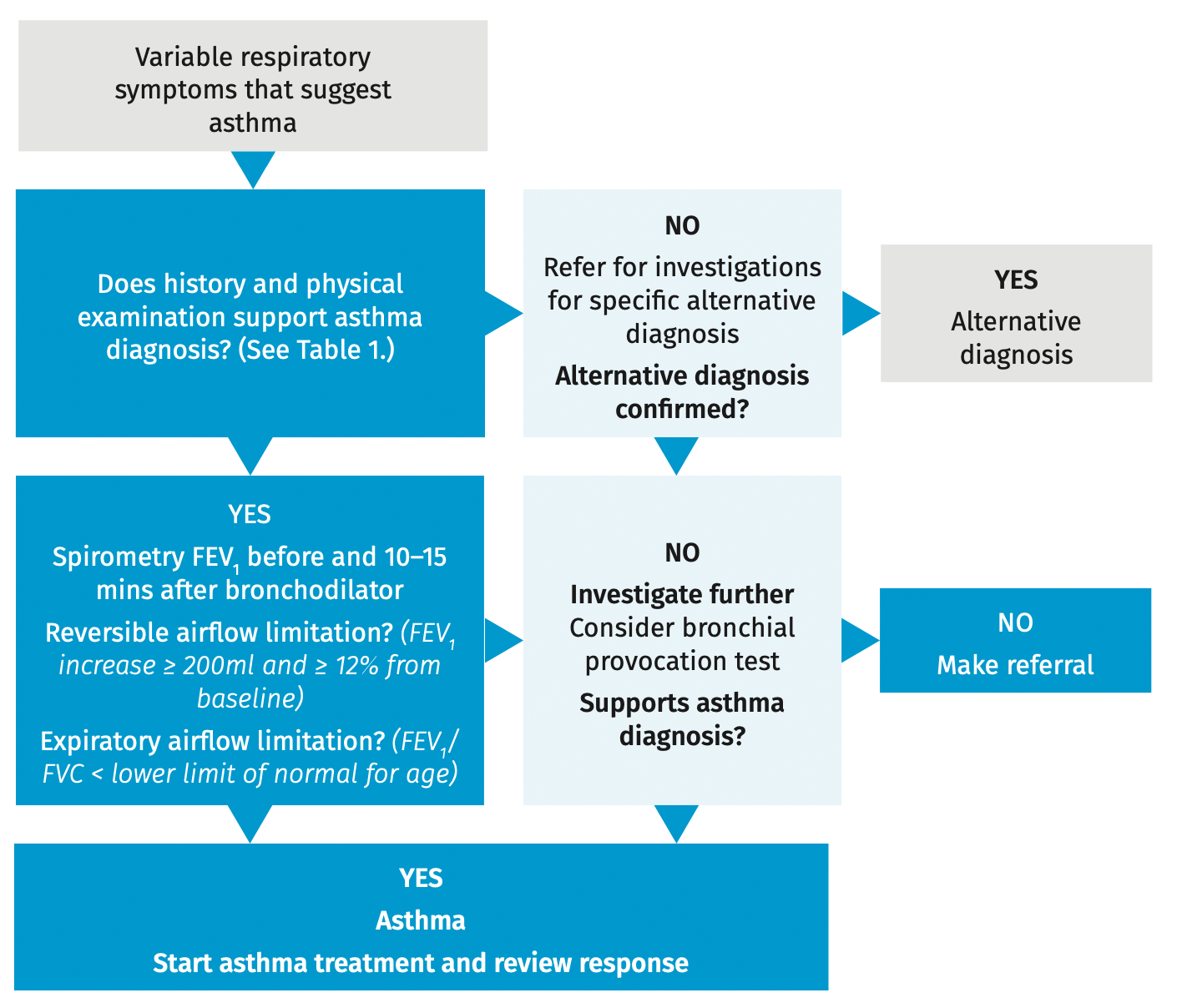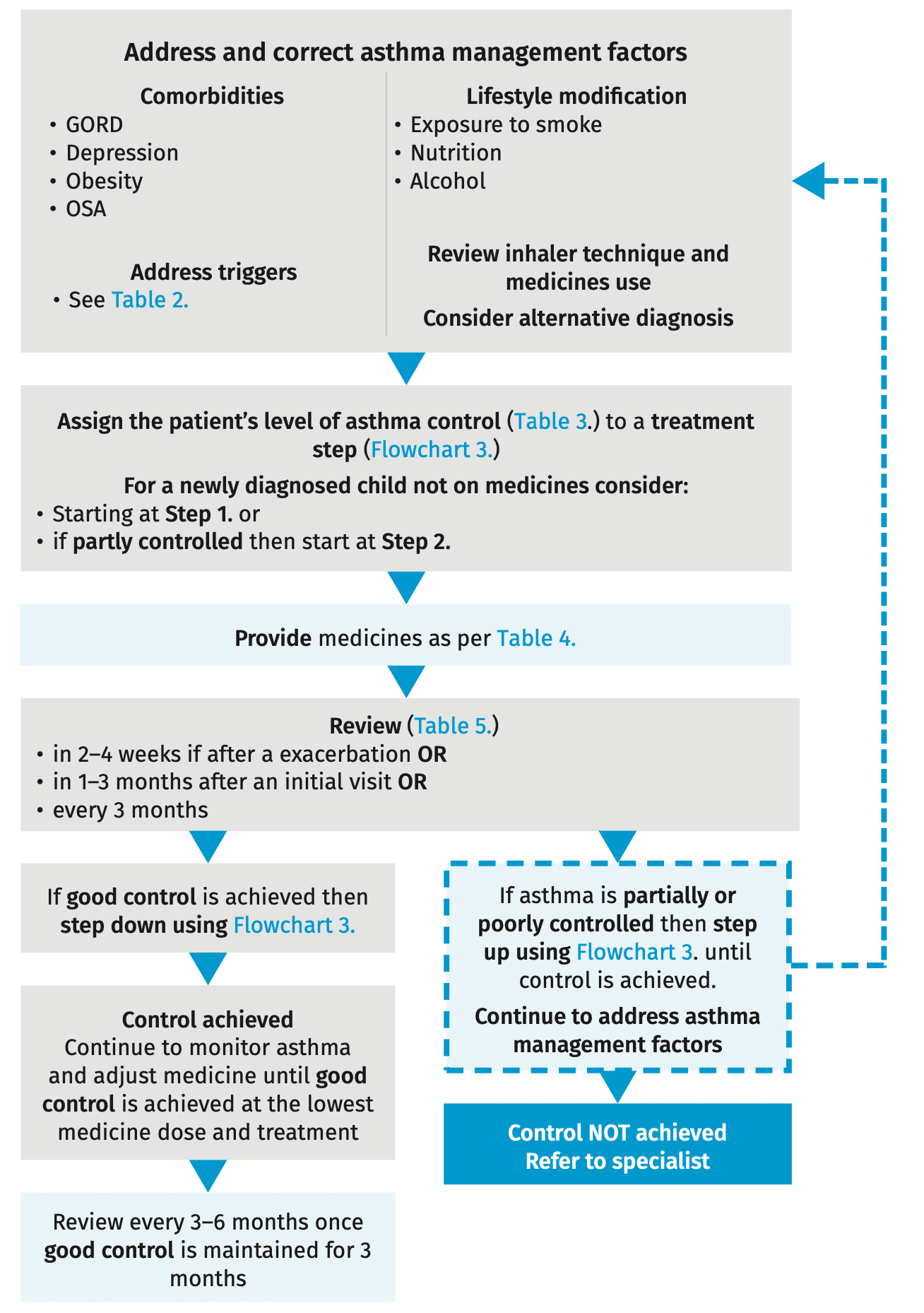High risk groups 1,2
- Adults and children over 12 years of age with a diagnosis of asthma
Considerations in pregnancy 2,3
- Asthma in pregnant women increases the risk of pre-eclampsia, preterm labour, low birth weight and babies small for gestational age
- Acute exacerbations should be treated aggressively to avoid fetal hypoxia
- Avoid exposure to tobacco smoke during pregnancy and first year of life
Urgent referral
- For an acute asthmatic episode see the Primary Clinical Care Manual
Special considerations
- A prior diagnosis of asthma should be corroborated by documented evidence
1. What is asthma? 2–4
- A chronic inflammatory disorder of the airways triggered by a range of factors
- A variation in lung function (especially expiratory airflow) and episodic respiratory symptoms such as wheezing, shortness of breath, cough and tight chest
- Episodes are usually associated with airflow obstruction that is often reversible either spontaneously or with treatment
- Airflow obstruction is due to airway wall inflammation causing oedema and mucus production
- Asthma is associated with allergies such as eczema and hay fever
- More common in women than in men
- More common among Aboriginal and Torres Strait Islander Australians
2. Diagnosis of asthma in adults and children > 12 2–4
- Based on a history, physical examination, consideration of other diagnoses and documented changes in airflow (spirometry). See Resources 1.
- If spirometry is unavailable, PEF before and after a therapeutic trial with as-needed SABA and regular ICS, often with a 1 week course of oral corticosteroids, helps to confirm a diagnosis of asthma prior to long-term treatment
- Airflow limitation demonstrated on spirometry and other respiratory symptoms does not always mean a person has asthma. Differential diagnoses include:
- Rheumatic heart disease Chronic obstructive pulmonary disease, Heart failure, Bronchiectasis, chronic upper airway cough syndrome, vocal cord dysfunction, hyperventilation and dysfunctional breathing, cystic fibrosis, inhaled foreign body, adverse drug reactions, lung disease, pulmonary embolism, central airway obstruction or congenital heart disease
- Asthma can be over or under diagnosed
- Table 1. outlines findings that increase or decrease the likelihood of asthma
Table 1. Findings that increase or decrease the probability of asthma in adults and children > 12 | |
|---|---|
Asthma is more likely to explain the symptoms if any of these apply | Asthma is less likely to explain the symptoms if any of these apply |
|
|
Adapted with permission from the Australian Asthma Handbook, Version 2.2. © 2022 National Asthma Council Australia. | |
- Flowchart 1. illustrates the steps to confirm an asthma diagnosis
Flowchart 1. Steps to diagnosing asthma in adults and children > 12

Adapted with permission from the Australian Asthma Handbook, Version 2.2. © 2022 National Asthma Council Australia
3. Management of adults and children > 12 with asthma 2–5
- The goals of managing asthma are to:
- engage the patient to identify asthma management goals
- minimise impact of asthma on quality of life
- optimise asthma symptom control with minimal medicines
- minimise risk of exacerbations and loss of lung function
- minimise adverse effects of treatment
- identify and address comorbid conditions including:
- hay fever
- rhinosinusitis
- GORD
- Depression and Anxiety disorders
- chronic infections
- OSA
- Support patient self-management 2,3
- Provide culturally appropriate asthma resources and support service details. See Resource 2.
- In partnership develop an asthma action plan (Resource 3.) identifying:
- asthma triggers. See Table 2.
- symptoms that indicate asthma is worsening
- actions to take when symptoms worsen
- when and how to use medicines and correct use of inhaler. See Resource 4.
- doses and frequencies of regular medicines
- how to adjust treatment in response to particular signs and symptoms
- when to start oral corticosteroids
- when and how to seek urgent medical help
- At each visit the asthma action plan should be reviewed and adjusted as required
- Patients who accept their asthma symptoms as normal, require added support to show that symptoms and quality of life will improve with correct medicine use, lifestyle modification and regular monitoring. See Resource 2.
- Encourage the patient to identify barriers to adequate lifestyle modification and
medical adherence and create goals to overcome those barriers. See Engaging our patients
- Social-emotional support 2–4
- Depression and Anxiety disorders are more common in people with asthma, attributing to a patient’s asthma symptom perception and medicine adherence
- See Social-emotional wellbeing
- Smoking cessation 2–5
- Review recent asthma symptom control every 3 months in those who smoke, due to increased risk of exacerbations and lung function decline over time
- Regularly encourage the patient to Smoking cessation
- Offer the patient Quitline details. See Resource 5.
- Obesity 1–5
- Asthma is more difficult to control in obese patients (BMI ≥ 30 kg/m2)
- Overweight and obesity (adult) and Overweight and obesity (child) is associated with an increased prevalence of asthma via mechanical, inflammatory and genetic/developmental factors
- 5–10% weight loss can lead to improved asthma control and quality of life
- The risk of asthma exacerbations is reduced in those who have a diet high in fresh fruit and vegetables and oily fish
- A diet high in processed foods and soft drink increases the risk of developing asthma
- See Diet and nutrition
Table 2. Summary of asthma triggers | |
|---|---|
Avoidable triggers | Unavoidable triggers |
Always avoid | Do not avoid |
|
|
Avoid or reduce if possible | Manage |
Allergens
Airborne/environmental irritants
Certain medicines
Dietary triggers
| Respiratory tract infections Certain medicines
Comorbid medical conditions
Physiological and psychological changes
|
Adapted with permission from the Australian Asthma Handbook, Version 2.2. © 2022 National Asthma Council Australia. | |
- Sleep hygiene 2–5
- OSA is high among people with asthma and is associated with upper and lower airway inflammation
- Medicines, difficulty breathing, anxiety and depression may prevent people with asthma from sleeping well at night
- Assess a patient’s daytime sleepiness and OSA risk by using a validated tool. If they score highly refer to a sleep specialist. See Resource 6.
- Asthma control 2–4
- Ascertain the patient’s recent level of asthma symptom control using Table 3.
- Recent asthma symptom control is based on symptoms over the previous 4 weeks
- When counting the times a patient uses their reliever puffer, do not include times taken before exercise (dose counters are now available on inhalers)
Table 3. Definition of levels of recent asthma symptom control in adults and children > 12 2,3 | |||
|---|---|---|---|
In the past 4 weeks, has the patient had | Well controlled | Partly controlled | Poorly controlled |
| None of these | 1–2 of these | 3 or more of these |
Sample questions for reviewing asthma control
| |||
4. Medicines for adults and children > 12 with asthma
- Use Flowchart 2. to assist with the steps to determine practical management and optimal medicine use for the patient with asthma
- Correct medicine use 2–4
- Monitor medicine adherence and correct inhaler technique according to product instructions. See Resource 4.
- SABA should only be used at the lowest dose and frequency when asthma symptoms occur or if prescribed for use before exercise
NOTE:
The risk of severe exacerbations and death is higher in patients who:
- overuse their SABA
- use an as-needed SABA in the absence of inhaled corticosteroids
- use inhaled corticosteroids incorrectly or infrequently
- are dispensed three or more canisters of SABA a year
- Medicine precautions in asthma 2–4
- Any newly obtained medicines (prescriptions, over the counter or complimentary) should be checked for asthma trigger risk. See Table 2.
- Sedatives are contraindicated during an acute asthma episode
Flowchart 2. Intervention flowchart to achieve asthma control 2,3,6

- Medicine review 2,3,6
- Patients should be reviewed:
- 2–4 weeks after an exacerbation OR
- 1–3 months after an initial visit with preference given to 3 months to ascertain the effectiveness of the medicine to control the asthma OR
- every 3 months
- If patient’s asthma is poorly controlled after 1–3 months, step up treatment
- See Flowchart 3.
- If good control is achieved for 2–3 months, step down treatment to the least medicine required to maintain control
- Monitor frequently once good control is achieved so that adjustments can be made in response to worsening symptoms or episodes of exacerbations
Flowchart 3. Stepped approach to adjusting asthma medicine in adults and children > 12 2,3,6 | |||
|---|---|---|---|
Step 4. | |||
Step 3. | Referral | ||
Step 2. | Few patients
PLUS
OR
OR
| ||
Step 1. | Some patients
PLUS
OR
OR
| ||
Most patients
PLUS
OR
OR
| |||
| |||
The use of SABA alone should be considered ONLY for patients with very infrequent symptoms and no risk factors for exacerbations | |||
* Montelukast can be used in children aged 12–14 years or in adults with exercise induced asthma. Review recent control and triggers regularly (see Tables 2. and 3.) | |||
Table 4. Medicines for adults and children > 12 with asthma 2,3,6 | |
|---|---|
SABA (reliever) | |
Salbutamol (pMDI) |
|
Terbutaline (DPI) |
|
ICS
| |
Beclometasone (pMDI) |
|
Budesonide (DPI) |
|
* Fluticasone propionate (pMDI or DPI) |
|
Combined ICS–LABA
| |
Budesonide and formoterol (maintenance and reliever e.g. Symbicort®) | Reliever only - low dose
Maintenance and reliever
NOTE Max dose includes reliever and maintenance doses combined |
Fluticasone propionate and formoterol (pMDI e.g. Flutiform®)* |
|
Fluticasone propionate and salmeterol (DPI or pMDI e.g. Seretide®, Pavtide®) |
|
LTRA | |
* Montelukast (oral) |
|
*See LAM and PBS for medicine indications and restrictions | |
Table 5. Reviewing and adjusting asthma treatment for adults and children > 12 2,3,6 | |||
|---|---|---|---|
Treatment | Review | Treatment response | |
Good | None | ||
SABA | 4 weeks |
|
Step up
|
ICS (low dose) | 4 weeks |
|
Step up
|
ICS–LABA (low dose) | 4 weeks |
|
Step up
|
ICS–LABA (medium to high dose) | 4 weeks |
|
|
5. Cycle of care
Cycle of care summary for adults and children over 12 with asthma | ||||
|---|---|---|---|---|
Action | Dx | Good control | Partial control | Poor control and smokers |
Height | - | - | - | |
Weight | 12 mthly | 6 mthly | 6 mthly | |
Spirometry | 12 mthly | 6 mthly | 3 mthly | |
Social-emotional wellbeing | 12 mthly | 6 mthly | 3 mthly | |
Lifestyle modification | 12 mthly | 6 mthly | 3 mthly | |
Self-management education | 12 mthly | 6 mthly | 3 mthly | |
Inhaler technique | Each visit | |||
Asthma action plan and asthma first aid | ||||
Symptom review | 12 mthly | 4 wkly and when changing medicines | ||
Medicine review | 12 mthly | |||
MO/NP review | 12 mthly | 6 mthly | 3 mthly | |
RN/IHW review | 12 mthly | 6 mthly | 3 mthly | |
Specialist MO | Any uncontrolled or difficult to treat asthma | |||
Influenza, pneumococcal, pertussis and COVID-19 vaccines | Recommended. See the Australian Immunisation Handbook for schedule | |||
Comorbidity management | Each time patient is assessed for asthma control | |||
6. References
- All Chronic Conditions Manual references are available via the downloadable References PDF
 Step up or down with worsening or improving condition
Step up or down with worsening or improving condition